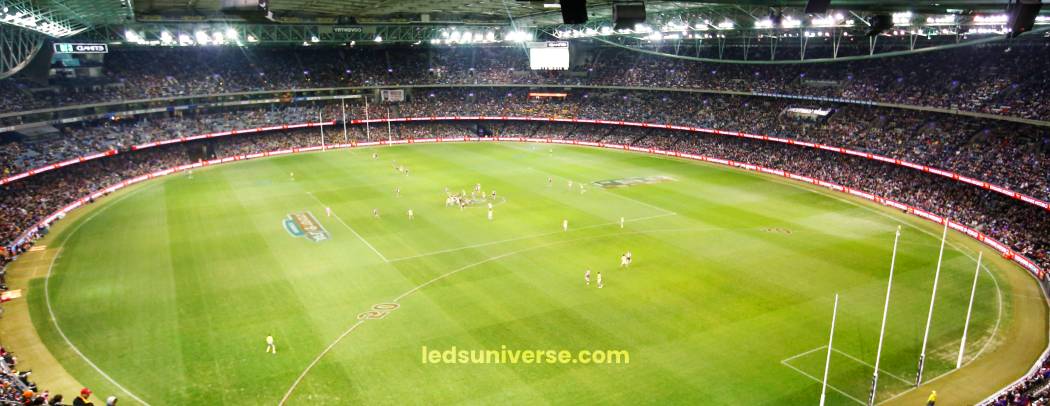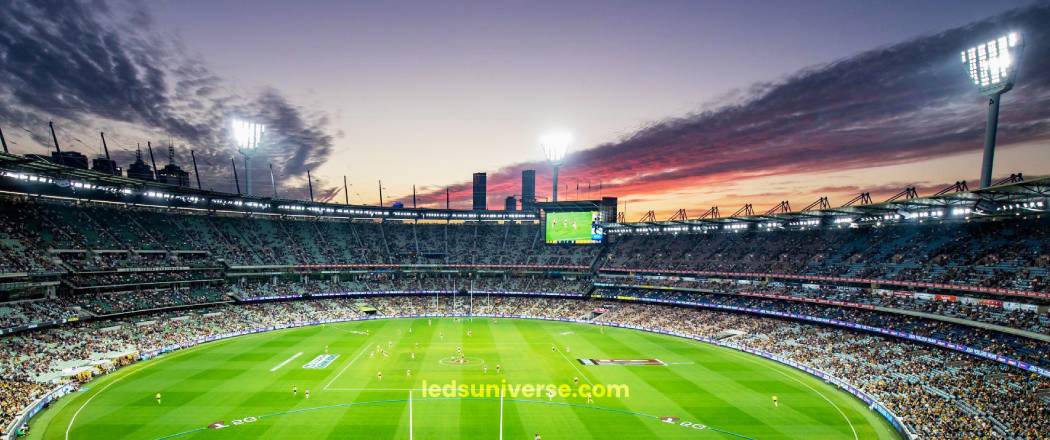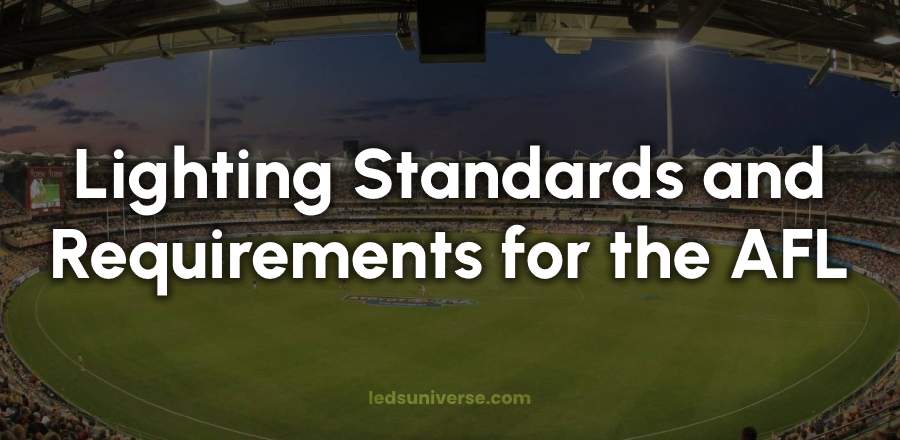Under the bright stadium lights, every kick, mark, and handball in an AFL match is brought into sharp focus. The speed of the game, the precision of the players, and the experience of thousands of fans hinge on one often-overlooked element: lighting. Designed to meet the demands of fast-paced action and high-definition broadcasts, the lighting standards for AFL stadiums ensure that the field is not just illuminated but transformed into a stage where every moment shines.
In the Australian Football League (AFL), meeting these standards is fundamental to ensuring that matches are conducted safely and efficiently. Proper lighting creates a visually clear environment, supports the pace of play, and enhances the spectacle for fans both in the stadium and watching via broadcast. Stadium lighting for AFL matches must be designed and implemented to meet specific requirements that take into account not only player performance but also the needs of broadcasters and spectators.
Table of Contents
ToggleOverview of Lighting Specifications for AFL Venues
Lighting requirements for AFL venues are determined based on several factors, including the size of the playing field, the intensity of play, and broadcast needs. The AFL has stringent guidelines that must be met to ensure that the lighting quality is appropriate for high-level performance. These guidelines typically focus on illuminance levels, uniformity, color temperature, and glare control.
Illuminance Levels
| Illuminance Type | Description | Recommended Levels (Lux) |
|---|---|---|
| Horizontal Illuminance | Amount of light falling onto the playing surface. Ensures clear visibility for players, referees, and key moments of the game. | 500 to 1500 lux |
| Vertical Illuminance | Amount of light falling onto vertical surfaces. Enhances visibility for cameras, ensuring clear broadcast footage. | Minimum of 750 lux |
Illuminance is the measure of the amount of light falling onto the playing surface, typically expressed in lux (lx). AFL games are fast-paced and require a high degree of visual clarity for both players and referees to make accurate decisions. For AFL matches, the recommended horizontal illuminance levels generally range between 500 to 1500 lux, depending on the level of competition. This ensures that the field is sufficiently lit, allowing for clear visibility of the ball, players, and key moments of the game.
Vertical illuminance is equally significant, especially for televised games. Adequate vertical illuminance enhances the visibility of players when viewed by cameras, which is essential for clear broadcast footage. The recommended vertical illuminance for AFL venues often starts at around 750 lux, ensuring that all on-field action is easily captured, regardless of the viewing angle.

Uniformity of Lighting
Consistency in lighting across the playing field is necessary for player safety and the overall viewing experience. Uniform lighting ensures that no area of the field is brighter or darker than another, which could potentially disrupt play. The AFL sets guidelines that stipulate a uniformity ratio between the minimum and maximum levels of illuminance on the field. Achieving a ratio that provides a balanced lighting distribution across the entire field contributes to a fair and comfortable environment for both players and referees.
Color Temperature and Color Rendering
In addition to illuminance and uniformity, color temperature and color rendering index (CRI) are critical aspects of AFL lighting standards. The color temperature of the lighting affects how colors appear on the field, while CRI refers to the light’s ability to accurately reproduce colors. The AFL specifies that the lighting in its venues must have a color temperature of around 5000K to 6000K, which is akin to daylight conditions. This helps ensure that the natural colors of the field and uniforms are maintained, enhancing both the live experience and television broadcasts.
A high CRI is needed to ensure that the colors of team uniforms, the ball, and other visual elements are represented accurately. A CRI of at least 80 is typically recommended for AFL venues, as this enhances visibility and reduces the likelihood of visual fatigue for both players and viewers.
Glare Control
Managing glare is another consideration when designing lighting systems for AFL venues. Glare can disrupt players’ vision and negatively impact the quality of play. It can also affect spectators’ and broadcasters’ ability to follow the game effectively. Therefore, stadium lighting systems are designed with glare control mechanisms that help minimize light spillage and reflection into the eyes of players, referees, and fans. Special lighting fixtures and angles are employed to direct light specifically onto the field, reducing unnecessary glare and maximizing visibility.
Energy Efficiency and Sustainability in AFL Lighting
As the AFL moves towards more sustainable practices, energy efficiency has become a focus in stadium lighting design. Many AFL venues are transitioning from traditional metal halide lighting systems to LED lighting. LED lights not only provide better illuminance and uniformity but are also more energy-efficient, consuming significantly less power than conventional lighting systems. This shift towards energy-efficient lighting helps reduce the overall carbon footprint of the stadium, aligns with environmental objectives, and lowers operational costs over time.
LED lighting systems are also known for their longer lifespan and reduced maintenance requirements, further contributing to their growing popularity in AFL venues. These systems offer enhanced control features, allowing for adjustments in brightness and lighting patterns, which can be tailored to the needs of different events or game conditions.

Broadcast Considerations for AFL Lighting
AFL matches are widely broadcast across various platforms, making the quality of stadium lighting a critical component of delivering a high-definition viewing experience. Television broadcasts, particularly in high definition and 4K resolution, demand higher levels of lighting precision and consistency. Broadcasters require a lighting system that provides sufficient vertical illuminance to capture the movement of players and the ball without any visual disturbances.
Shadowing can also be a concern in broadcast environments. Lighting designs for AFL venues must account for potential shadowed areas on the field, ensuring that camera angles capture clear footage without areas of excessive darkness. Strategic placement of lights around the stadium helps mitigate this issue, distributing light evenly across the entire playing area.
Spectator Experience and Comfort
For spectators in the stadium, lighting plays a role in both comfort and visibility. Proper lighting allows fans to follow the action on the field clearly, regardless of their seating position. For night games, particularly, it ensures that the stadium atmosphere remains vibrant and engaging without creating discomfort due to excessive brightness or glare. The positioning of light fixtures is carefully planned to avoid shining directly into the eyes of spectators, while still illuminating the field to a high standard.
In addition to field lighting, attention is given to other areas of the stadium, such as concourses, seating areas, and entrances, ensuring that the overall experience is seamless for fans from the moment they enter the venue.
Safety Considerations for AFL Lighting
Lighting design in AFL venues must also address safety for both players and spectators. Adequate lighting reduces the risk of accidents and injuries during play by providing clear visibility of the field and surrounding areas. For instance, in cases of poor weather conditions or during twilight hours, high-quality lighting is necessary to maintain safe playing conditions.
Emergency lighting systems are also part of the standard requirements, ensuring that, in the event of a power outage, the venue remains illuminated enough for safe evacuation. These systems are typically backed up by generators or other power sources to ensure they are reliable when needed.
Technological Advancements in AFL Lighting
The development of lighting technologies has enhanced the quality and efficiency of lighting in AFL venues over the years. Innovations such as smart lighting controls, dynamic lighting, and programmable LED systems have introduced new levels of customization and flexibility. These advancements allow lighting operators to adjust brightness levels, color temperatures, and even lighting patterns during the course of a game or event.
For instance, dynamic lighting can be used for pre-game entertainment, halftime shows, or celebrations, offering a more immersive experience for fans. Programmable systems also allow for more efficient use of energy, as lighting can be dimmed or increased depending on the needs of the event.
Compliance with Australian Standards for Sports Lighting
AFL lighting requirements align closely with the broader Australian standards for sports lighting, specifically AS 2560.2.3-2007, which outlines guidelines for lighting in outdoor sports venues. This standard provides the technical framework for illuminance, uniformity, glare control, and other aspects of stadium lighting. Compliance with these standards ensures that AFL venues not only meet league requirements but also adhere to national safety and performance guidelines.
Regular audits and assessments of lighting systems are conducted to ensure that they remain in line with both AFL and Australian standards. These evaluations often involve testing the illuminance levels, assessing the uniformity ratios, and checking for any potential issues with glare or shadowing.
Conclusion
Lighting standards and requirements in the AFL are grounded in providing optimal conditions for players, broadcasters, and fans. Through the careful design of lighting systems that account for illuminance, uniformity, color rendering, and energy efficiency, AFL venues create an environment that enhances the spectacle of the game while ensuring safety and comfort. Technological advancements and sustainable practices will continue to shape the future of AFL lighting, ensuring that stadiums meet evolving demands while maintaining high-quality performance.
